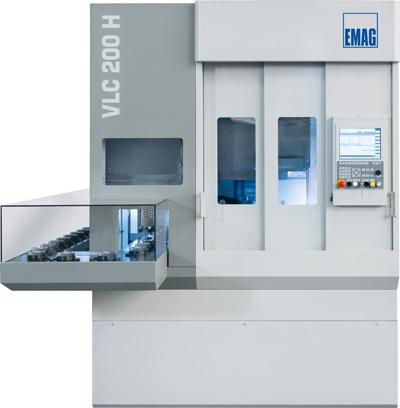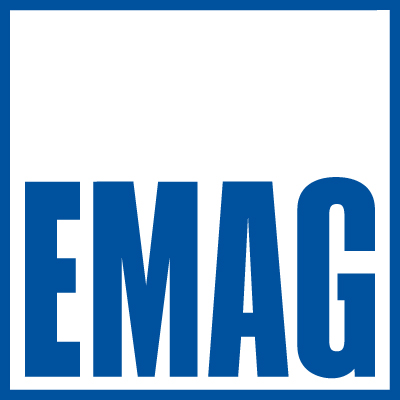
Drivers are already used to the sixth gear, and the development continues. There are plans afoot for an automatic gearbox for a 9-gear transmission system. The reason is obvious, since it allows the car to be driven at optimal speeds for longer intervals and that saves fuel. Together with the continuing pressure to optimize, high volume gear production must become faster and cheaper. The EMAG Group has demonstrated their solution: the VLC 200 H Vertical Hobbing Machine that adds a new dimension to productivity levels.
According to the German Federal Statistical Office, the German transmission sector generated a combined turnover of over 17 billion EURO last year alone, with a continuing upward trend. Consistently increasing production volume keeps the industry firmly in the mind of production planners, especially those in the automotive industry, where demand rises for faster, more efficient production. Yet they want guarantees that quality is maintained despite an increasingly demanding component. This comes as no surprise, considering transmission technology accounts for a large percentage of research costs in the automotive industry according to experts.
KOEPFER, a subsidiary of EMAG, is no stranger to this dynamic. Not just a supplier of machines for the high-quality gear production, KOEPFER is also a competent partner for anything to do with the gear. For decades now they have invested heavily in industry developments. A product of close collaboration within the EMAG Group, the VLC 200 H is the latest result of these efforts. The VLC 200 H vertical hobber is the first KOEPFER machine based on the new modular standards of EMAG, bearing the name of the new standard machine platform that represents a new generation of machine tools for use in a range of greatly varying applications. This "modular approach" is of great advantage when it comes to establishing a highly efficient production system for the transmission industry, as it allows for the individual processes used in the soft machining of a gear, from turning of the raw part to hobbing and deburring, to be combined with perfection and without any great outlay for automation.
"The machines are easy to interlink, as they are perfectly coordinated and work at the same transfer height," explains Jörg Lohmann of KOEPFER.
A closer look at the VLC 200 H hobbing machine reveals a technology that offers the user great economic advantages, even in its stand-alone version. The machine features high-performance drives offering top main spindle and hobbing speeds. Gears of a maximum diameter of 200mm and module 4 can be dry-milled at greatly shortened cycle times. Removal of the hot chips generated by the process is of no concern on vertical machines, as they fall unhindered into the chip conveyor below. The typical EMAG pick-up design principle also minimizes idle times. The main spindle removes the raw-part from the conveyor belt, transfers it to the tailstock, where it is firmly supported during machining by a tailstock flange, and removes it from the machining area after completion of the hobbing cycle. This integrated automation concept with short travels not only makes for efficient speeds, but also guarantees a high degree of machine availability.
The VLC 200 H also guarantees exceptional and consistent component quality. This it owes, in part, to the vibration-resistant polymer concrete MINERALIT machine base. An optional measuring probe can be integrated into the machining area and used for either positioning tasks or the measuring of finish-machined components. "It even allows us to carry out adjustments in the machining process. In fact, the whole machine provides added value with its integrated production process quality control," Lohmann states.
Designed on the basis of a modular platform, production planners have a choice where this automated high-efficiency package is to be integrated into a manufacturing system. They can choose directional component flow, recirculating automation or the "chaku-chaku" principle. A processing concept, meticulously planned by EMAG experts, ensures the lowest cycle times: after turning of the raw parts on an EMAG VL 2 the gear cutting process is carried out on the VLC 200 H, with the final deburring and single-sided chamfering process following on the VLC 100 D. All these machines are designed on the "modular standard" basis from EMAG. The gearing is generated in a single cut and followed only by chamfering, in comparison to alternative production solutions that rely on a second cut after chamfering. Cycle times for the machining of gears will drop dramatically with modular EMAG solutions and KOEPFER technology.
Lohmann considers the market opportunities for the VLC 200 H from KOEPFER as positive: "When it comes to optimizing large-volume gear production or developing processes, we offer a highly efficient solution with integrated automation that can be configured a number of different ways. It should signal a new, interesting approach to production planners."
Contact Details
Related Glossary Terms
- chamfering
chamfering
Machining a bevel on a workpiece or tool; improves a tool’s entrance into the cut.
- quality assurance ( quality control)
quality assurance ( quality control)
Terms denoting a formal program for monitoring product quality. The denotations are the same, but QC typically connotes a more traditional postmachining inspection system, while QA implies a more comprehensive approach, with emphasis on “total quality,” broad quality principles, statistical process control and other statistical methods.
- turning
turning
Workpiece is held in a chuck, mounted on a face plate or secured between centers and rotated while a cutting tool, normally a single-point tool, is fed into it along its periphery or across its end or face. Takes the form of straight turning (cutting along the periphery of the workpiece); taper turning (creating a taper); step turning (turning different-size diameters on the same work); chamfering (beveling an edge or shoulder); facing (cutting on an end); turning threads (usually external but can be internal); roughing (high-volume metal removal); and finishing (final light cuts). Performed on lathes, turning centers, chucking machines, automatic screw machines and similar machines.

